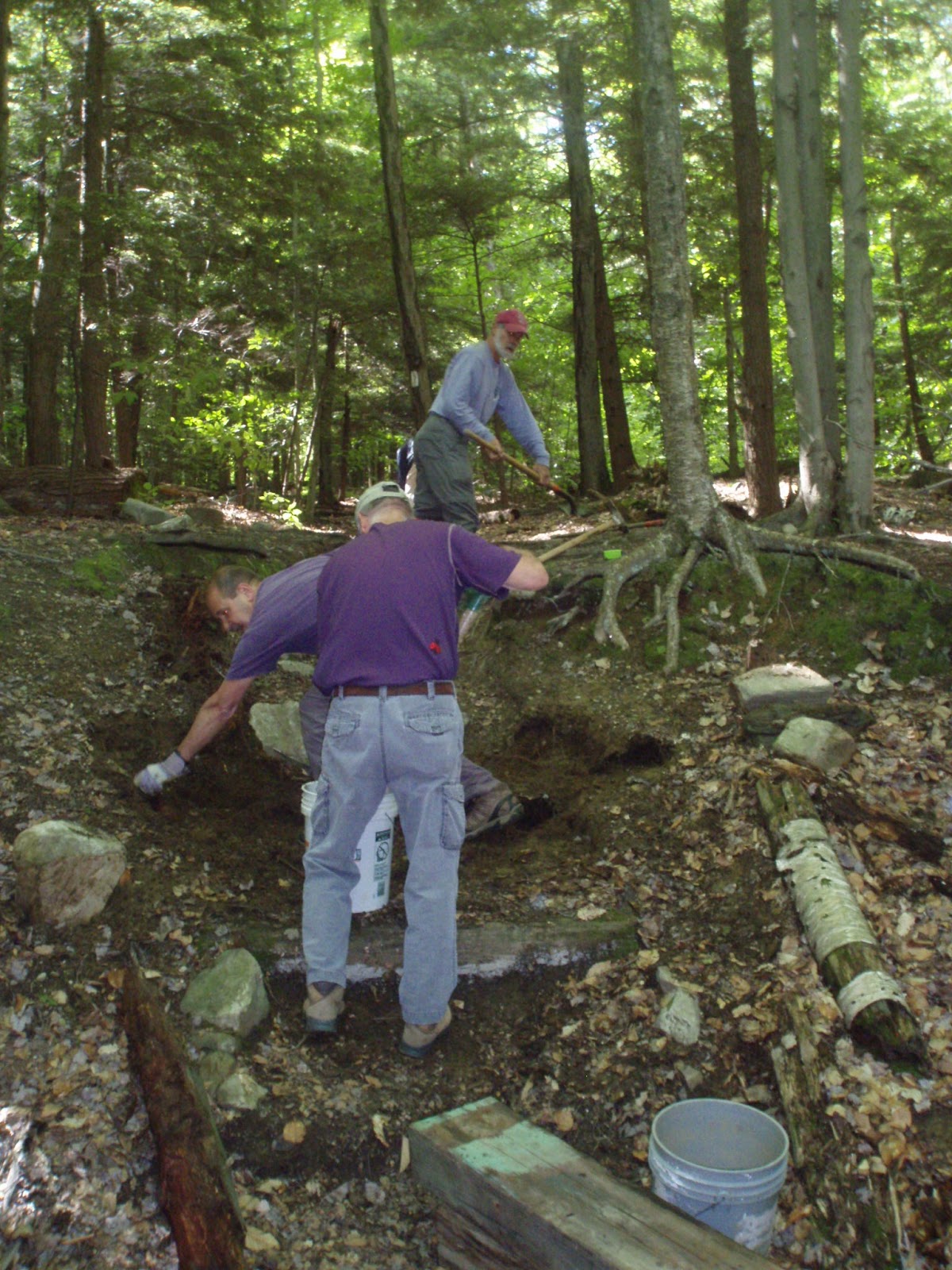Today we addressed a long-standing problem on the Trail just south of Furnace Hill Rd, in Cheshire. The trail crosses a deep drainage dip, probably created when the land was logged off in the mid-1900's. At the bottom of this ditch we built a simple bridge about 5 years ago, but the 12ft climb back up through soft soils has been the site of a number of solutions over the past years, none of which were very satisfactory.
For this attempt, we decided to use large timbers to provide durable steps up this steep slope. Many years ago, a trail volunteer salvaged some 6x10 timbers from a bridge being demolished in Pittsfield. For a long time they have sat in the pile of materials adjacent to our toolshed waiting for the appropriate project.
We cut several of the timbers into 5 ft lengths and pulled out all of the old nails that were still embedded in the wood from its previous life. Being treated with preservative, these chunks were really heavy, probably over 100lbs each. Fortunately, the project was close to the road and we had a good crew on hand to tote these beasts up the hill.
Once on site, we demolished was was left of a rotting stair made from native logs, and a few of the undersized rock steps that were sliding down the hill.
 |
| Clearing out the former steps |
 |
| Setting the timbers |
 |
| Don drives rebar to pin the steps |
 |
| Denis places rock to secure the timbers |

Once secured, the gaps between the timbers are filled in with mineral soil harvested from a "borrow pit" dug out of sight of the trail. Mineral soil is the dirt that is below the soft 'living' layer that supports most of the plant life in the woods. Mineral soil doesn't contain any roots or vegetation, so it packs down well, and won't shrink over time. The borrow pit is then filled in with brush and branches to as not to be a hazard to people who are off-trail.
So, you may be saying, "these timbers don't look very natural, why didn't you use rocks, or logs harvested from a nearby tree or two?" Rocks certainly would have been a longer lasting and more natural looking material, but large enough rocks were not available in this location. To survive, rocks for steps must be very large, so most of their bulk can be buried in the soil, otherwise they won't stay in place. The smaller rocks at this location just did not have what it takes. Locally harvested logs were previously installed and lasted only a few seasons in this damp location. The treated bridge timbers will last longer, and being close to the road and within sight of neighborhood houses, we did not feel we were diminishing the trail experience for hikers. Another alternative, building side-hill trail that would switchback up the slope with no structures, was not possible in this location either. We would need approximately 75 feet of footpath to climb this slope, and AT lands here are very narrow--we would have been well onto the neighbor's property. So here we are with timbers.
An important final element to the project was the construction of a large drainage dip just uphill from the stairs. No matter what materials or type of construction we installed, if large quantities of water pour over the steps in heavy rains, nothing will stay in place for long. The drain will divert water coming down the hill away from the steps. The local maintainer will need to make sure debris does not collect in the drain--if it is overwhelmed, we'll eventually loose the stairs too.
 Just as we were wrapping up, we had our first customer, an NB thruhiker, who seemed to have no difficulty traversing our work. Apologies for the shovel handle in the picture, my photoshop skills aren't up to removing it.
Just as we were wrapping up, we had our first customer, an NB thruhiker, who seemed to have no difficulty traversing our work. Apologies for the shovel handle in the picture, my photoshop skills aren't up to removing it.Cosmo
Used this to send info to a local club. Thanks for the details Cosmo!
ReplyDeleteThis is great! I'm looking to making some of these steps myself. Do you remember how deep you went with the rebar stakes?
ReplyDelete